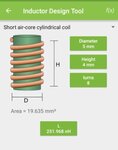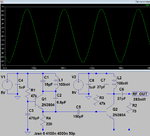sleepy04
Newbie level 4
Hi everyone,
I'm building a small FM transmitter circuit as following. It works fine and I can listen the sound from microphone by a FM radio.

This transmitter is design at around 82 Mhz ( L is 0.5cm diameter, 8 turns of 0.5mm wire). The Colpitts frequency calculation confirmed this.
However a strange thing is when I connect the circuit to a spectrum analyser, it shows the most powerful signal in 41Mhz (1/2f), 82 Mhz and 164 Mhz.
How can it happen? I read about harmonic and it seems only happen at 2f, 4f...
Thanks.
BRs/.
I'm building a small FM transmitter circuit as following. It works fine and I can listen the sound from microphone by a FM radio.

This transmitter is design at around 82 Mhz ( L is 0.5cm diameter, 8 turns of 0.5mm wire). The Colpitts frequency calculation confirmed this.
However a strange thing is when I connect the circuit to a spectrum analyser, it shows the most powerful signal in 41Mhz (1/2f), 82 Mhz and 164 Mhz.
How can it happen? I read about harmonic and it seems only happen at 2f, 4f...
Thanks.
BRs/.




